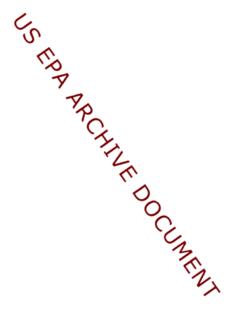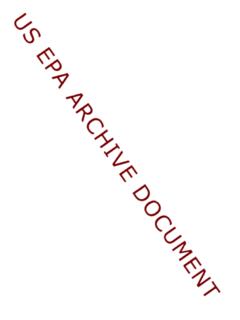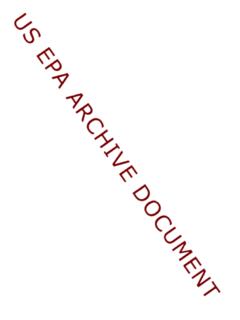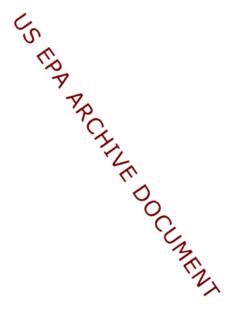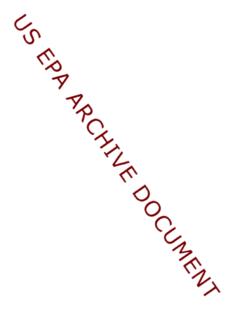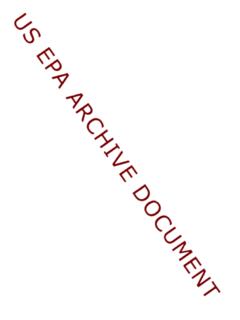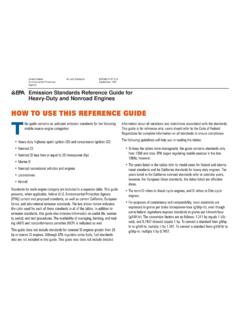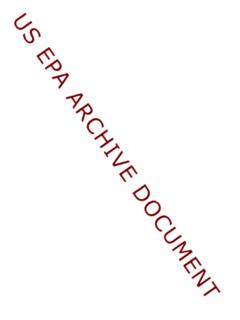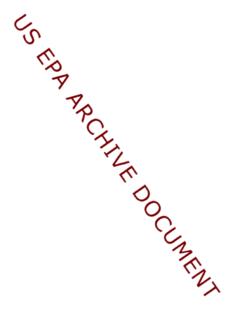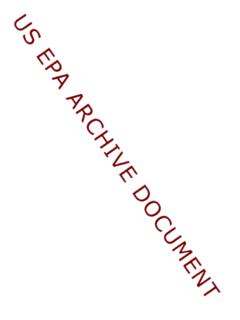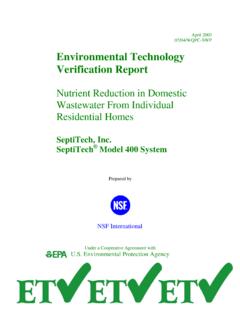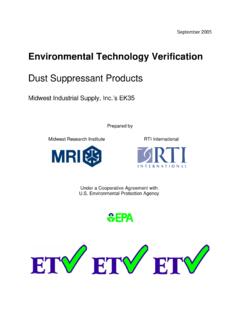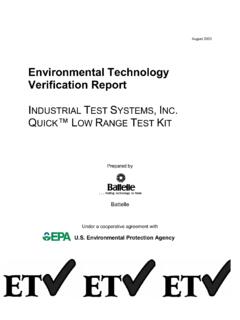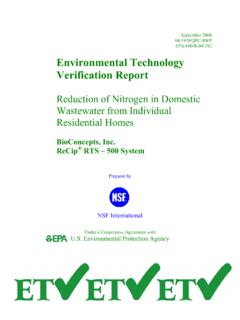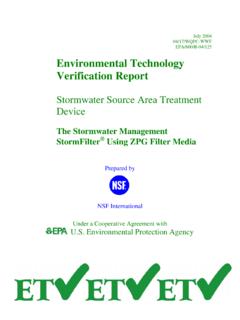Transcription of Environmental Technology Verification Report - US EPA
1 September 2009 Environmental Technology Verification Report ABRAXIS ECOLOGENIA 17 -ESTRADIOL (E2) MICROPLATE ENZYME-LINKED IMMUNOSORBENT ASSAY (ELISA) TEST KITS Prepared by Battelle Under a cooperative agreement with Environmental Protection Agency September 2009 Environmental Technology Verification Report ETV Advanced Monitoring Systems Center ABRAXIS ECOLOGENIA 17 -ESTRADIOL (E2) MICROPLATE ENZYME-LINKED IMMUNOSORBENT ASSAY (ELISA) TEST KITS By Stephanie Buehler, Zachary Willenberg, Amy Dindal, Battelle Eric Kleiner, Michelle Henderson, and John McKernan, EPA ii Notice The Environmental Protection Agency, through its Office of Research and Development, funded and managed, or partially funded and collaborated in, the research described herein.
2 It has been subjected to the Agency s peer and administrative review and has been approved for publication. Any opinions expressed in this Report are those of the author (s) and do not necessarily reflect the views of the Agency, therefore, no official endorsement should be inferred. Any mention of trade names or commercial products does not constitute endorsement or recommendation for use. iii Foreword The EPA is charged by Congress with protecting the nation s air, water, and land resources.
3 Under a mandate of national Environmental laws, the Agency strives to formulate and implement actions leading to a compatible balance between human activities and the ability of natural systems to support and nurture life. To meet this mandate, the EPA s Office of Research and Development provides data and science support that can be used to solve Environmental problems and to build the scientific knowledge base needed to manage our ecological resources wisely, to understand how pollutants affect our health, and to prevent or reduce Environmental risks.
4 The Environmental Technology Verification (ETV) Program has been established by the EPA to verify the performance characteristics of innovative Environmental Technology across all media and to Report this objective information to permitters, buyers, and users of the Technology , thus substantially accelerating the entrance of new Environmental technologies into the marketplace. Verification organizations oversee and Report Verification activities based on testing and quality assurance protocols developed with input from major stakeholders and customer groups associated with the Technology area.
5 ETV consists of six Environmental Technology centers. Information about each of these centers can be found on the Internet at Effective verifications of monitoring technologies are needed to assess Environmental quality and to supply cost and performance data to select the most appropriate Technology for that assessment. Under a cooperative agreement, Battelle has received EPA funding to plan, coordinate, and conduct such Verification tests for Advanced Monitoring Systems for Air, Water, and Soil and Report the results to the community at large.
6 Information concerning this specific Environmental Technology area can be found on the Internet at iv Acknowledgments The authors wish to acknowledge the support of all those who helped plan and conduct the Verification test, analyze the data, and prepare this Report . We sincerely appreciate the involvement and support of all staff from the participating laboratories who conducted testing as part of this Verification test. In particular, we would like to thank the following staff for their contribution in conducting this Verification at their respective laboratories: Mark Mills and Scott Jacobs, EPA NRMRL, Cincinnati, OH; Jennifer Gundersen, Dave Russell, Ronald Landy, Annie Hilliard, John Curry, and Martin Lazarus, EPA Region 3 Fort Meade, MD; Dennis Wesolowski, Larry Zintek, and Charles Steiner, EPA Region 5 Chicago, IL; Mike Meyer, Keith Loftin, Larry Barber, and James Gray, USGS, Kansas.
7 Jim Lazorchak, Tirumuru Reddy, and Dan Bender, EPA NERL, Cincinnati, OH; and Jeanette Van Emon, EPA NERL Las Vegas, NV. Finally, we would like to thank Lisa Olsen, USGS; Paul Pennington, NOAA, and Marion Kelly, EPA, for their review of this Verification Report . v Contents Notice .. iiPage Foreword .. iii iv List of Abbreviations .. vii Chapter 1 Background .. 1 Chapter 2 Technology Description .. 2 Chapter 3 Test Design and Procedures .. 4 Introduction ..4 Test Facilities ..5 Test Procedures.
8 6 Test Sample Collection and Preparation .. 7 Test Sample Analysis Procedure .. 8 Chapter 4 Quality Assurance/Quality Control .. 10 Quality Control Samples ..10 GC-MS Blank and Surrogate Spike Results .. 10 Method Blanks .. 11 Audits ..11 Performance Evaluation Audit .. 11 Technical Systems Audit .. 12 Data Quality Audit .. 13 QA/QC Reporting ..13 Data Review ..13 Chapter 5 Statistical Methods .. 15 Precision ..15 Percent Bias ..16 Matrix Effects ..16 Operational Factors.
9 17 Chapter 6 Test Results .. 18 Precision ..18 Percent Bias ..19 Matrix Effects ..20 Operational Factors ..22 Chapter 7 Performance Summary .. 24 Chapter 8 References .. 26 vi Figures Figure 2-1. Abraxis 17 -Estradiol (E2) microplate ELISA Test Kit ..2 Tables Table 3-1. Target Analytes .. 5 Table 3-2. ELISA Test Kit Evaluation Responsibilities for Each Participating Laboratory .. 5 Table 4-1. PE Audit Sample Results .. 12 Table 4-2. Summary of Data Recording Process .. 14 Table 6-1.
10 ELISA Test Kit Average Concentration and Relative Standard Deviation (RSD) Results .. 19 Table 6-2. ELISA Test Kit Percent Bias vs. GC-MS .. 19 Table 6-3. GC-MS Average Concentration, RSD, and Percent Bias Results .. 20 Table 6-4. ELISA Test Kit Percent Bias vs. Expected Spike Concentration .. 21 Table 6-5. Percent Recovery .. 21 Table 6-6. Concentrations of Cross-Reactive Compounds .. 22 vii List of Abbreviations AMS Advanced Monitoring Systems C degrees Celsius COC chain of custody DI deionized E1 estrone E2 17- -estradiol E3 estriol EDC endocrine-disrupting compound EE2 17- -ethynylestradiol ELISA enzyme-linked immunosorbent assay EPA Environmental Protection Agency ETV Environmental Technology Verification GC-MS gas chromatography mass spectrometry GFF glass fiber filter HPLC high performance liquid chromatography L liter LC-MS liquid chromatography mass spectrometry
